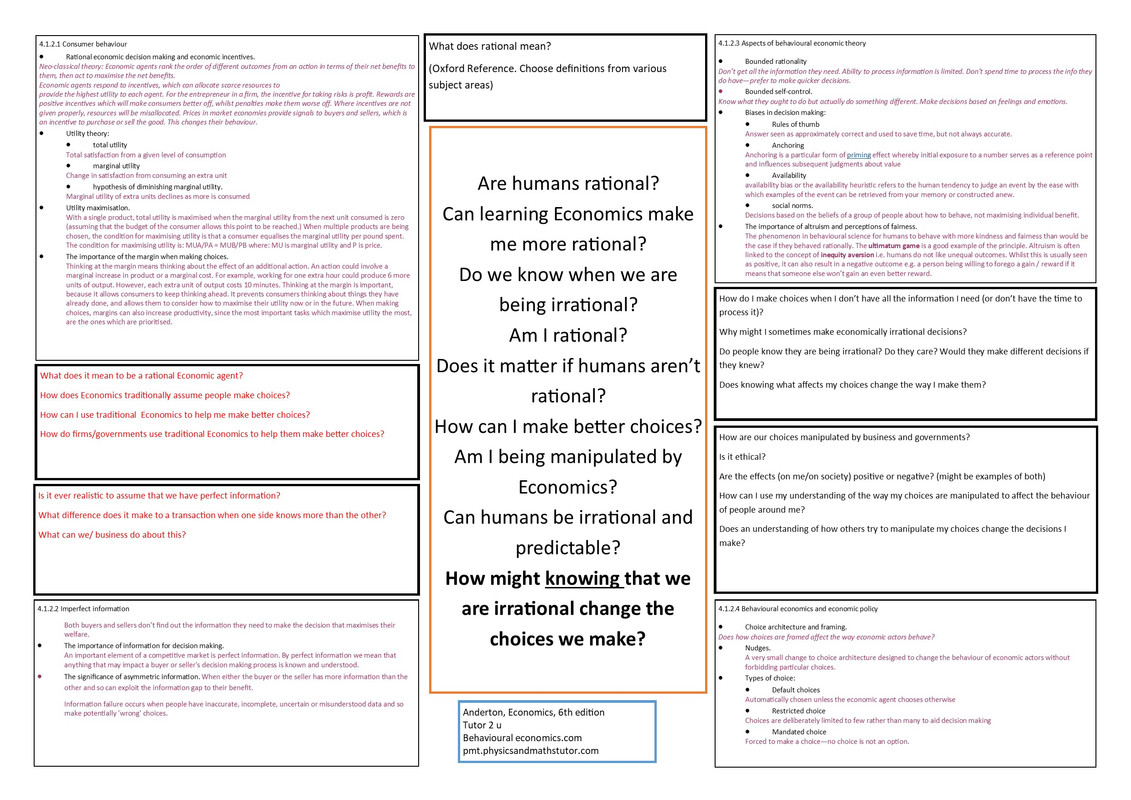A-Level Economics inquiry – Behavioural Economics
Home › Forums › Inquiry and resource design › A-Level Economics inquiry – Behavioural Economics
- This topic has 2 replies, 2 voices, and was last updated 6 years, 7 months ago by
 Jenny Toerien.
Jenny Toerien.
-
AuthorPosts
-
7th May 2019 at 2:14 pm #1258
This inquiry which ran last summer was the first that I was involved with from the planning stages to the end. It was a steep learning curve for me (which I’m still on!) and any questions or comments would be very welcome.
March 2018
Following a short TeachMeet session in which Jenny (Library Assistant responsible for developing resources to support inquiry) introduced a guide to ‘Designing Successful Inquiries’, we were approached by Sam for help with designing an inquiry. As Lead Practitioner, Sam was the Economics teacher leading the teaching of Behavioural Economics at A-Level. As trips and events during the second half of the summer term often mean higher absences from lessons, he felt that a well-designed independent inquiry would be an appropriate and effective way of progressing the four groups of Year 12 students through the Behavioural Economics topic at this time.
Late April 2018
Having rapidly read up on the topic to make sure we understood the terminology, Jenny and I met with Sam just after the Easter holidays to discuss how this topic had been taught before and to look at what were the key themes to be covered. We also needed to discuss the best case scenario in terms of weeks / number of lessons / time devoted to prep for this topic. It was important at the early stages to make sure that we were designing a format that was practically possible.
It emerged that there were 4 key themes within the specification for this topic and that about 8 lessons could be devoted to this with around 2 hours prep in total. Initial thoughts for an inquiry question were along the lines of ‘Are human beings rational?’
May 2018
Within the library, we then got to work on planning how, within this time frame, we could step the students through the FOSIL inquiry process and used OneNote as a tool to share ideas and begin to build an inquiry. Sam was also keen that Economics games formed part of the final product.
In agreement with Sam, we settled on the following inquiry question suggested by Darryl (Head of Library):
“What you don’t know has power over you; knowing it brings it under your control, and makes it subject to your choice. Ignorance makes real choice impossible.” Abraham Maslow
In the light of this quotation, answer the following question: Does knowing that we are irrational help us to make more rational decisions?
This question includes the original question, in that students need to address the premise of the question (humans are not rational, which they may or may not agree with), but is more open. This is important for differentiation, allowing the more able to stretch themselves, while allowing others to make their way through the content at a slower pace. Because this question needs to be unpacked in two stages, it also shifts the focus of the inquiry from finding out someone else’s answer via Google to constructing an understanding of their own answer.
The inquiry started to take shape, beginning with students brainstorming ideas connected to the inquiry question to clarify what they already know and what they would like to find out. These ideas and questions would be separated by the teacher leading the session into the four key themes and groups would then be assigned to further explore each area. Following this further investigation in their groups they would begin to construct an understanding of their allocated theme and would allow them to address the question from this perspective.
Sam had expressed to us that the students had some familiarity with OneNote and we felt this would be an excellent tool for the students working together and learning from each other, in light of the expected pupil absences.
Each group would express their findings in the form of a lesson for the remaining groups, using examples, games and discussion questions to guide the rest of the class through their topic. This lesson plan must also be available on OneNote not only for the use by absent pupils but to serve as a revision guide for the pupils.
Mid May 2018
The pupil Notebook that Jenny and I had begun work on was shared with Sam. Deciding on using this tool for the pupils greatly facilitated our collaboration with him in fine tuning the inquiry. It enabled different ideas and perspectives on the inquiry to be immediately accessible by all involved, including other economics teachers who would be involved in working with the students on this topic. This month saw a great deal of collaboration between the library and the economics department that simply wouldn’t have been possible to that degree if we’d operated solely on the basis of face to face meetings.
By the end of May, we had created a rather detailed class notebook containing 3 key areas:
Collaboration space: for each group to record their research and explain its relevance and to plan their lesson. This included a checklist for the required elements – not just for the final product but also for the forms of scholarly resources to be used for their research. Also they were required to self-assess their work as part of the reflection process.
Content library: Containing useful information such as the project brief, lesson breakdowns, recommended scholarly resources and the assessment sheet.
Teacher only: We created this restricted section of the notebook to help teachers with guiding the students through the inquiry if required. Some teachers were going to be more comfortable than others with guiding this sort of an inquiry. Sam agreed it would be helpful to have tips available to them if they needed them, such as tips on using the subscription databases or question ideas if the initial student brainstorming session needed a bit of a prompt (see below. Click on image for larger PDF version), rather than submitting to the temptation to start teaching the topic if met with silence from the pupils. Whilst Jenny and I were involved in the ‘investigate’ lessons, this meant that any last minute changes to timing of lessons could at least have a ‘virtual’ librarian presence through this Notebook section.
June
The inquiry ran for 2 ½ weeks and Jenny gathered feedback from staff involved and also pupils to gain thoughts on how this process could be improved for future years.
9th May 2019 at 7:31 pm #1280Thanks for that excellent summary Madeleine – particularly given that this happened a while ago, so reconstructing the whole process so clearly must have been a challenge! This inquiry had several interesting aspects, which is why we thought it was worth reporting back on.
Firstly, the question itself. As a non-specialist I thought “Are human beings rational?” sounded like a great question when Sam first suggested it…until I did a quick web search and discovered it was a fairly common and very topical question in behavioural economics and there were lots of “off the shelf” answers out there just waiting to be copied and pasted. Producing the brainstorming sheet was our way of thinking our way into the topic with a focus on the exam specification that the department wanted the students to cover, and exploring the kinds of questions that might help them to do that. The exercise was a useful reminder, if one was needed, that Connect and Wonder are just as important for us in designing an inquiry as they are for the students undertaking it. This exercise led to the subtle change of question to “Does knowing that we are irrational help us to make more rational decisions?”, which pushed students to think a bit more for themselves and construct an understanding that would help them to answer the question. It also reassured everyone involved that that question could easily encompass all the relevant areas of the specification.
Secondly, the delivery method. We were relatively new to OneNote and had only started using it in earnest as a Library team to collaborate with each other in December 2017. It struck us as a really powerful tool for inquiry because it allowed us to group together all the resources students would need in one place, and to organise them easily with comments, instructions and downloadable resources. Most importantly, however, the ClassNotebook is also a very powerful collaborative tool for students:

- It allows everyone in a team to see what everyone else has done (and when), so if a student is absent for a lesson their team won’t be stuck because they don’t have access to their files.
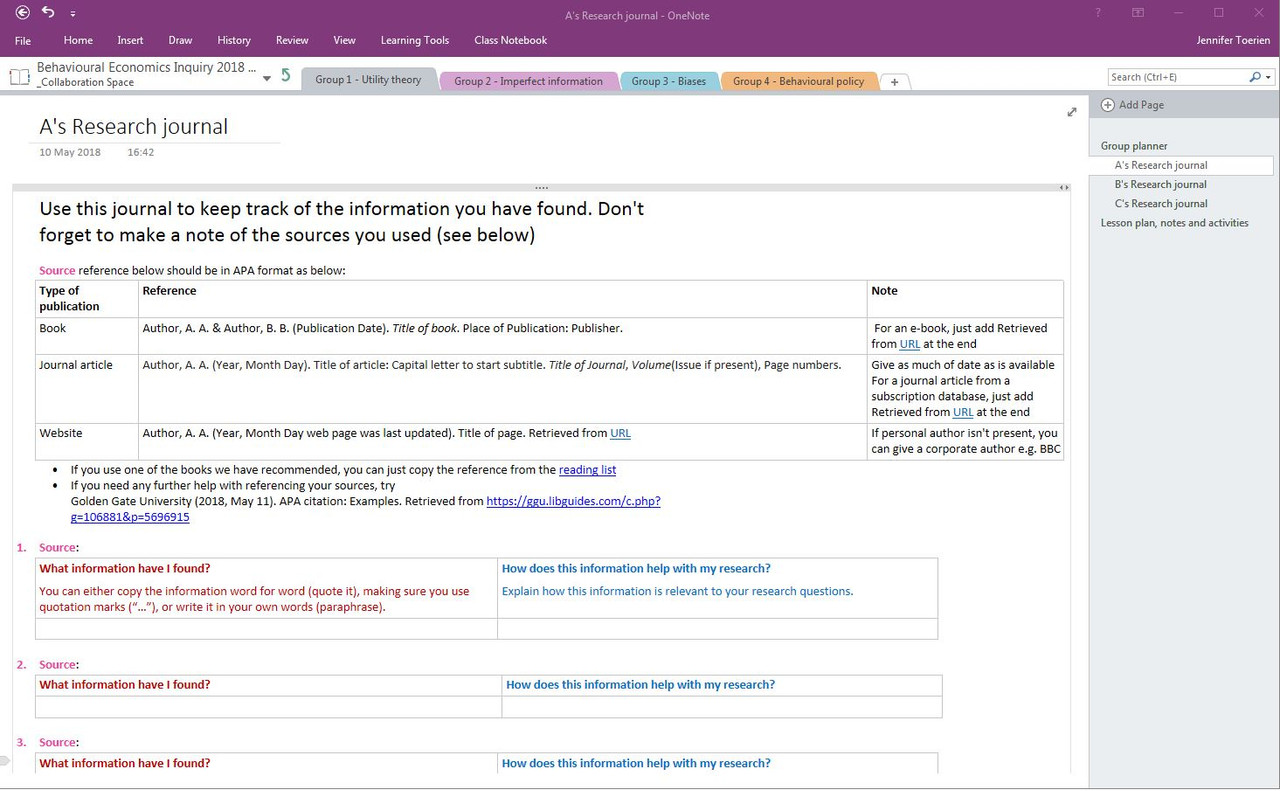
- It also allows the team to collaboratively create ‘To do’ lists so that everyone knows what is expected of them.
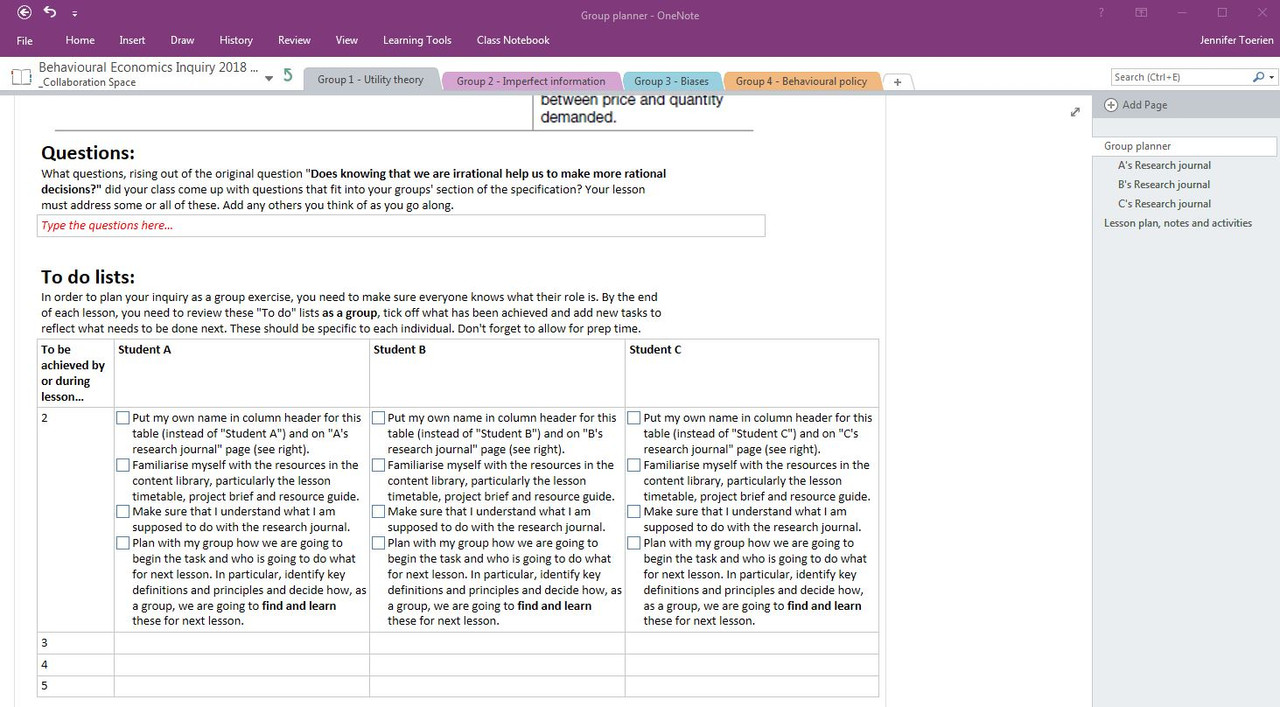
- It allows the teacher to see what every individual in the team is doing, making it easier to assess individual contributions to a group project.
- Teachers can control access to sections of the notebook so that students cannot access other teams’ sections during the inquiry, but can open this up once the inquiry has finished so they all have access to the resources other teams have produced.
- In this case it also meant that the Library staff could be added as Teachers to the Notebook so we could see how the inquiry was progressing, which helped us both to prepare for the lessons where we were team teaching and to critically reflect on the inquiry after it had finished.
It helped that some of the Economics staff were already using ClassNotebooks with their groups, so many students were familiar with them, but in setting up the inquiry in this way we also needed to be able to provide technical support as we assisted with the inquiry to make sure students could access all the materials.
9th May 2019 at 7:39 pm #1281After the inquiry we sent all the students a survey over email using Forms (also Office 365), offering entry into a small prize draw to incentivise completion. It was the last week of the summer term, so unfortunately the response rate was just 24% (9/38 students), however it was a good cross-section of the groups involved and a range of opinions were represented. The feedback was overwhelmingly positive, with most students finding the inquiry interesting and agreeing that the skills they learnt during the process were important. In general they found the OneNote document useful for collaboration, although 2 of the 9 found it difficult to find all the information they needed. In retrospect I think it may have been over-complicated and if we did this again I would work on streamlining it.
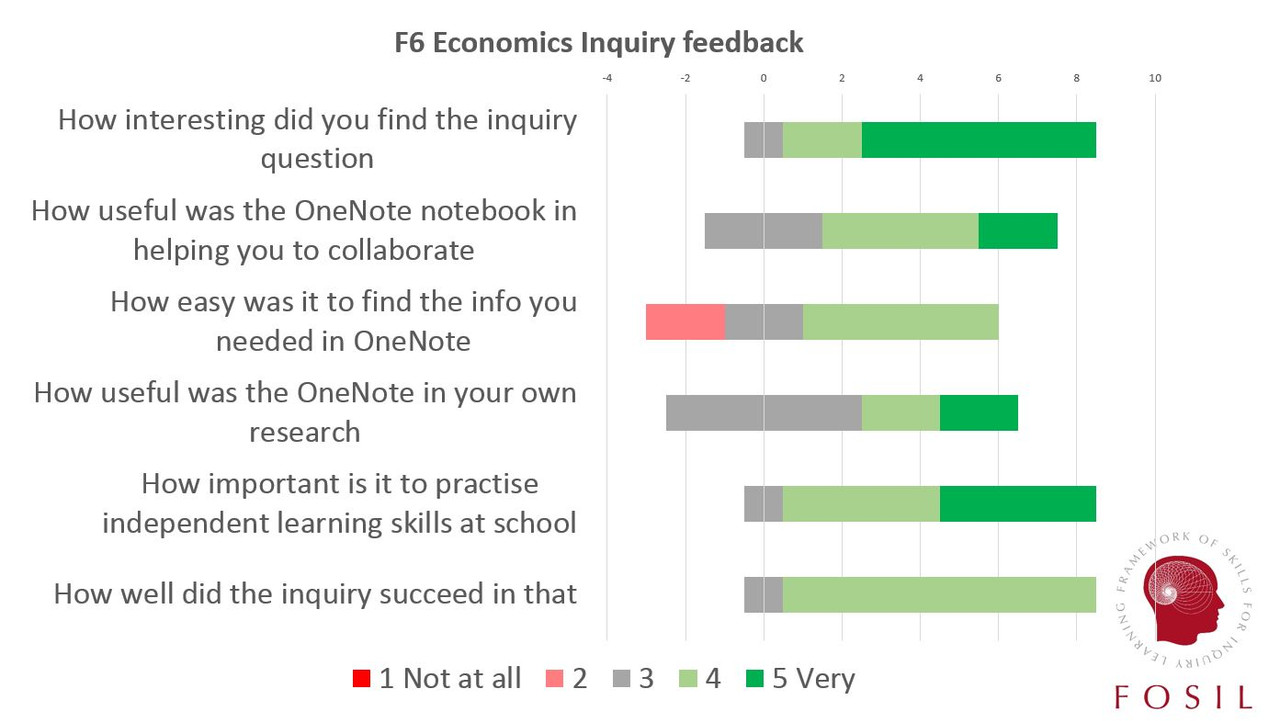
The image below shows the answers to the two questions “How well do you think you understood the topics your group/other groups presented, compared with topics your teacher has taught in a more traditional manner?”. It is a striking endorsement of inquiry learning that most students felt that they understood the topic that they had investigated better (or at least no worse) than if they had been taught it in a traditional manner. They were generally less certain about topics that other groups had investigated and presented back to them, and clearly if this were to become a regular feature of their lessons we would need to work on strengthening this aspect.

The slides above were part of a larger presentation on inquiry learning at a TeachMeet in January 2019, and it was so valuable to have concrete feedback to share. I would definitely use Forms in this way again in the future.
-
AuthorPosts
- You must be logged in to reply to this topic.
